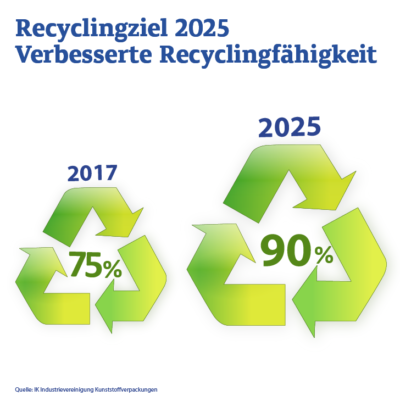In your supermarket, you probably notice only a few unpackaged foods. In the vegetable section you will find vegetables wrapped in plastic, cheese wrapped in plastic in the refrigerated section and noodles or rice are also often filled in plastic bags.
But does food packaging have to be? How can you recognise sustainable packaging? Is plastic packaging sustainable? If it is cleverly developed and used sensibly, it is. It is even more sustainable than comparable alternatives. Above all, it protects food - even from being thrown in the bin.
Saving food
Eleven million food items end up in the bin every year. The campaign week against food waste of the Federal Ministry of Food and Agriculture draws attention to this fact. In addition to more attentiveness on the part of consumers, well-designed food packaging made of plastic protects food: those who save on packaging risk damaged or spoiled goods. And these end up in the rubbish - which consumes significantly more resources than sensibly used packaging. In addition, plastic packaging is flexible and light, which improves the CO2 balance during transport.
Who is winning the race?
White, light, dark, with fruit, nuts or nougat: in supermarkets we find our favourite chocolate packaged in paper, cardboard, plastic or aluminium. Which food packaging is the best? The clear winner: plastic packaging. It is very light and the plastic polyethylene (PE) is very recyclable if you dispose of the packaging in the yellow bag or the yellow bin. In addition, manufacturers need much less energy and resources to produce plastic film than they do to produce aluminium foil.
Moving on to mustard: Which packaging is the most environmentally friendly: tube, plastic cup or bottle or glass? A study by the Institute for Energy and Environmental Research (ifeu) commissioned by the Nature and Biodiversity Conservation Union Germany (NABU) names the plastic cup made of polypropylene (PP) the best disposable packaging. The cup with lid is lighter than all other packaging variants, which has a positive effect on fuel consumption during transport. In addition, PP is a plastic that can be easily recycled. The aluminium tube brings up the rear: The production and transport of the heavy aluminium tube and the plastic lid consume huge amounts of energy and resources.
It is more difficult with yoghurt: here it depends on the perspective. The plastic cup with a cardboard label and aluminium lid has the least impact on the environment - if you separate the components correctly when disposing of them. In terms of consumption of non-renewable resources, however, the regionally marketed returnable glass with a disposable lid comes off best. On the other hand, the light plastic cup with an aluminium lid causes the fewest pollutant emissions.
Climate-friendly packaging
As you can see, packaging is rarely clearly good or bad. Moreover, the sustainable differences in packaging are not always obvious to consumers. Compostable packaging, for example, sounds good, but so far it has been banned in German organic bins and must be incinerated with the residual waste. Plastic-coated paper seems sustainable, but the material mix makes it difficult or impossible to recycle. It is by no means more sustainable than plastic.
The basis for climate-friendly packaging is what is known as Eco Design: the intelligent use of all available resources is intended to achieve the greatest possible benefit for all stakeholders - along the entire value chain, with minimal environmental impact and under socially fair conditions.
An important aspect of Eco Design is Design for Recycling. True to the motto "As little as possible, as much as necessary", the more efficiently raw materials are used, the less damage there is to the climate and the environment. The goal is therefore to pollute the environment as little as possible through the ideal packaging design and at the same time to optimally protect the packaged goods. This requires optimised production processes, the intelligent use of resources and optimal recycling of waste. Design for Recycling combines and ensures product protection and the best possible recyclability of packaging. The latter in order to promote the circular economy of plastic packaging and thus contribute to environmental protection.
www.kunststoffvrpackungen.de
